Geology and mineralization of the Dayin’gezhuang supergiant gold deposit (180 t) in the Jiaodong Peninsula, China: A review
2022-11-28XiangongLiuZhngjiangDingMinghunSongMinglingZhouShaohuiXuZhnliangYangTianXiTaoCuiYingxinSongXukanGaoRuixiangLiLiangliangZhangQiinZhangShanshanWangBinWang
Xiang-ong Liu , Zhng-jiang Ding *, Ming-hun Song, Ming-ling Zhou Shao-hui Xu Zhn-liang Yang Tian-i Xi Tao Cui, Ying-xin Song, Xu-kan Gao, Rui-xiang Li Liang-liang Zhang Qi-in Zhang Shan-shan Wang Bin Wang
a No.6 Geological Team of Shandong Provincial Bureau of Geology and Mineral Resources, Weihai 264209, China
b Ministry of Natural Resources Technology Innovation Center for Deep Gold Resources Exploration and Mining, Weihai 264209, China
c State Key Laboratory of Geological Process and Mineral Resources, China University of Geosciences (Beijing), Beijing 100083, China
d Hebei Key Laboratory of Strategic Critical Mineral Resources, Hebei GEO University, Shijiazhuang 050031, China
e Shandong Institute of Geological Sciences, Jinan 250013, China
f Dayin’gezhuang Gold Company, Zhaojin Mining Co., Ltd., Zhaoyuan 264000, China
Keywords:Stepped metallogenic model Thermal uplifting-extension mineralization Geological characteristics Supergiant gold deposit Zhaoping metallogenic belt Jiaodong gold province Mineral exploration engineering Dayin’gezhuang Shandong Province China
ABSTRACT The Dayin’gezhuang gold deposit is located in the central part of the Zhaoping Fault metallogenic belt in the Jiaodong gold province—the world’s third-largest gold metallogenic area. It is a typical successful case of prospecting at a depth of 500-2000 m in recent years, with cumulative proven gold resources exceeding 180 t. The main orebodies (No. 1 and No. 2 orebody) generally have a pitch direction of NNE and a plunge direction of NEE. As the ore-controlling fault, the Zhaoping Fault is a shovel-shaped stepped fault, with its dip angle presenting stepped high-to-low transitions at the elevation of -2000-0 m. The gold mineralization enrichment area is mainly distributed in the step parts where the fault plane changes from steeply to gently, forming a stepped metallogenic pattern from shallow to deep. It can be concluded from previous studies that the gold mineralization of the Dayin’gezhuang gold deposit occurred at about 120 Ma. The ore-forming fluids were H2O-CO2-NaCl-type hydrothermal solutions with a medium-low temperature and medium-low salinity. The H-O isotopic characteristics indicate that the fluids in the early ore-forming stage were possibly magmatic water or mantle water and that meteoric water gradually entered the ore-forming fluids in the late ore-forming stage. The S and Pb isotopes indicate that the oreforming materials mainly originate from the lower crust and contain a small quantity of mantle-derived components. The comprehensive analysis shows that the Dayin’gezhuang gold deposit was formed by thermal uplifting-extensional tectonism. The strong crust-mantle interactions, large-scale magmatism, and the material exchange arising from the transformation from adakitic granites to arc granites and from the ancient lower crust to the juvenile lower crust during the Early Cretaceous provided abundant fluids and material sources for mineralization. Moreover, the detachment faults formed by the rapid magmatic uplift and the extensional tectonism created favorable temperature and pressure conditions and space for fluid accumulation and gold precipitation and mineralization.
1. Introduction
The Jiaodong gold province, with more than 5000 t of proven gold resources, is the world’s third-largest gold metallogenic area, where three kiloton-class gold orefields,i.e., Sanshandao, Jiaojia, and Linglong, have been successively discovered ( Deng J et al., 2019; Song MC et al.,2021a, 2022a; Yue XF et al., 2020). The Dayin’gezhuang gold deposit is located in the central part of the Zhaoping Fault metallogenic belt in the Jiaodong gold province. More than 50 t of gold resources were discovered in this deposit in the 1970s. With the implementation of the strategy for deep deposit prospecting and the National Exploration &Development Planning, great progress has been made in the deep and peripheral prospecting of the Dayin’gezhuang gold deposit since the 21stcentury. At present, this deposit has cumulative proven gold resources of more than 180 t, making it the largest gold deposit in the central portion of the Zhaoping Fault zone.
A lot of studies have been conducted on the Dayin’gezhuang gold deposit (Li H et al., 1998; Shen K et al., 2000;Li DX et al., 2006; Wang QF et al., 2007; Yang LQ et al.,2009; Deng J et al., 2011; Yang LQ et al., 2014a; Liu Y et al.,2014; Zhang L et al., 2014; Zhang RZ et al., 2016; Zhang BL et al., 2017; Chai P et al., 2019a, 2019b; Mao XC et al., 2019,2020; Yuan ZZ et al., 2019; Chen J et al., 2020a, 2020b; Deng H et al., 2020; Wei YJ et al., 2020, 2022; Shen YK et al.,2022; Xie TC et al., 2022), achieving many important results on ore-controlling factors, alteration and mineralization characteristics, metallogenic age, ore-forming stages, ore deposit geochemistry, ore-forming fluids, and ore-forming material sources. However, previous studies are mainly based on the exploration results at an elevation of -800-0 m, while lacking systematic analysis of deep metallogenic characteristics and the spatial occurrence patterns of orebodies. In recent years, the authors of this paper have completed gold exploration at an elevation of -2000-0 m in the Dayin’gezhuang gold deposit and systematically revealed the deep characteristics of the deposit. This paper systematically reviewed the main achievements in shallow prospecting in the past and deep prospecting in recent years in the Dayin’gezhuang gold deposit, expatiated the main characteristics of the deposit, analyzed the spatial distribution and deep variations of orebodies, and summarized the previous study results on metallogenic age and ore deposit geochemistry. Based on these, the ore-controlling regularity of faults and the metallogenic age were analyzed, the properties and sources of the ore-forming fluids and the sources of the ore-forming materials were discussed, and the genetic model of the Dayin’gezhuang gold deposit was finally proposed. This paper is significant for deeply understanding the metallogenic regularity and formation mechanisms of Jiaodong gold deposits and for guiding deep prospecting.Moreover, it provides a typical model for deepening research on the mineralization of the Jiaodong gold deposits—Mesozoic gold deposits in the Precambrian metamorphic basement.
2. Regional geology
The Jiaodong gold province, where the Dayin’gezhuang gold deposit is located, experienced multi-phase tectonic superposition. In particular, the strong Yanshanian tectonomagmatic movement caused the Mesozoic metallogenic explosion (Mao JW et al., 1999; Zhai MG et al., 2004). The Jiaodong Peninsula is mainly composed of two tectonic units,i.e., the Jiaobei Terrane in the North China Plate and the Sulu Terrane in the Qinling-Dabie-Sulu Orogen (Fig. 1; Yang LQ et al., 2014b; Deng J et al, 2020a, 2020b; Fan HR et al.,2021). The Jiaobei Terrane, located on the southeastern margin of the North China Plate, consists of the Jiaobei uplift in the north and the Jiaolai Basin in the south. The Sulu Terrane, located on the northeastern margin of the Qinling-Dabie-Sulu Orogen, mainly consists of the Weihai uplift. The Jiaobei uplift is mainly composed of Precambrian metamorphic basement rocks and Mesozoic intrusions, with a small amount of Paleogene-Neogene volcanic rocks and clastic sediments and Quaternary loose sediments distributed in the coastal area. The Precambrian metamorphic basement is mainly composed of the amphibolites (metagabbros), biotite leptynites, and plagiogneisses of the Neoarchean Jiaodong Group, the Neoarchean gneisses of tonalite-trondhjemitegranodiorite (TTG) affinity (the TTG gneisses), the marbles,schists, diopsides, and leptynites of the Paleoproterozoic Jingshan and Fenzishan groups, and the metamorphic sedimentary rocks of both the Mesoproterozoic Zhifu Group and the Neoproterozoic Penglai Group. The Jiaolai Basin is a Cretaceous continental basin composed of continental volcanic-sedimentary rocks, including the Early Cretaceous Laiyang and Qingshan groups and the Late Cretaceous-Paleocene Wangshi Group (Li SJ et al., 1998; Li JL et al., 2007; Ren FL et al., 2008). The Weihai uplift, as a part of the Triassic collisional orogenic belt between the North China Plate and the Yangtze Block, is mainly composed of the ultrahigh-pressure metamorphic belts and Mesozoic intrusions. The ultrahigh-pressure metamorphic belt is mainly composed of Neoproterozoic granitic gneisses and a small quantity of Neoarchean-Paleoproterozoic metamorphic supracrustal rocks and is interbedded with eclogites and mafic-ultramafic rock lenses (Ames L et al., 1996; Liu LS et al., 2018). This metamorphic belt underwent eclogite-facies ultrahigh-pressure metamorphism at 240-220 Ma (Wallis et al., 1999). Mesozoic intrusions are widely distributed in the Jiaodong area and can be divided into Upper Triassic granites(Shidao rocks; Chen JF et al., 2003; Gao TS et al., 2004; Guo JH et al., 2005; Chen JZ and Jiang N, 2011), Upper Jurassic granites (Linglong and Wendeng granites; Zhang J et al.,2010; Jiang N et al., 2012; Ma L et al., 2013; Yang LQ et al.,2018), Earliest Lower Cretaceous granodiorites (Guojialing granites; Liu Y et al., 2014; Geng K et al., 2016), and Latest Lower Cretaceous granites (Weideshan and Laoshan granites;Guo JH et al., 2005; Goss SC et al., 2010). In addition, a large number of intermediate-mafic dikes are distributed in the Jiaodong Peninsula (Deng J et al., 2017). Geological structures of different ages, levels, properties, and styles overlap in Jiaodong Peninsula, forming a complex tectonic framework, which shows the mutual superimposition of E-Wand NE-NNE-trending structures overall (Deng J and Wang QF, 2016). The Precambrian tectonic deformation is characterized by folds and ductile shear zones, forming a nearly E-W-trending basement. The Mesozoic tectonic deformation is characterized by brittle faults, which mainly have a NE-NNE strike, followed by nearly E-W and NWNNW strikes, presenting a NE-NNE-trending fault pattern overall. The large-scale NE-NNE-trending faults include the Sanshandao Fault, Jiaojia Fault, Zhaoping Fault, Xilin-Douya Fault, Mouping-Jimo Fault, and Mouping-Rushan Fault from west to east. These faults control more than 90% of the proven gold resources in the Jiaodong Peninsula (Deng J and Wang QF, 2016; Deng J et al., 2019; Ma YX et al., 2021; Yao XF et al., 2021; Ma XH et al., 2021). The nearly E-Wtrending structures mainly include the nearly E-W-trending folds along the axial direction in the Precambrian metamorphic basement and their associated nearly E-Wtrending faults, which jointly form an E-W-trending fold-fault belt (Deng J et al., 2019). The NW-NWW-trending structures,with a dip direction of NE or SW, a dip angle of 60°-80°,several to dozens of kilometers long and dozens to hundreds of meters wide, are mainly distributed in the northwestern Jiaodong Peninsula. They are generally post-mineralization faults (Deng J et al., 2019).

Fig. 1. a-Regional geological sketch map; b-geological map of the Jiaodong gold province showing the distribution of gold deposits in terms of size (modified from Chough SK et al. 2010; Deng J et al. 2020a, 2020b; Song MC et al. 2020a). GJF-Guocheng-Jimo Fault; HQF-Haiyang-Qingdao Fault; HSF-Haiyang-Shidao Fault; JJF-Jiaojia Fault; MRF-Muping-Rushan Fault; RCF-Rongcheng Fault; SSDF-Sanshandao Fault;TCF-Taocun Fault; WHF-Weihai Fault; WYF-Wulian-Yantai Fault; XDF-Xilin-Douya Fault; ZDF-Zhuwu-Dianji Fault; ZPF-Zhaoping Fault.
3. Ore deposit geology
3.1. General geology
The Dayin’gezhuang gold deposit is located in the central part of the Zhaoping Fault zone (Fig. 2a). The footwall of the Zhaoping Fault zone mainly consists of Upper Jurassic Linglong granites, which contain massive Mesozoic dikes.The hanging wall of the Zhaoping Fault zone is mainly composed of Neoarchean TTG gneisses, with Neoproterozoic Jingshan Group distributed locally. Fault structures are well developed, including the dominant NNE-trending Zhaoping Fault, the NE-trending Houcang and Luanjiahe faults, and the NW-trending Nanzhoujia, Dayin’gezhuang, and Nangou faults (Fig. 2b).
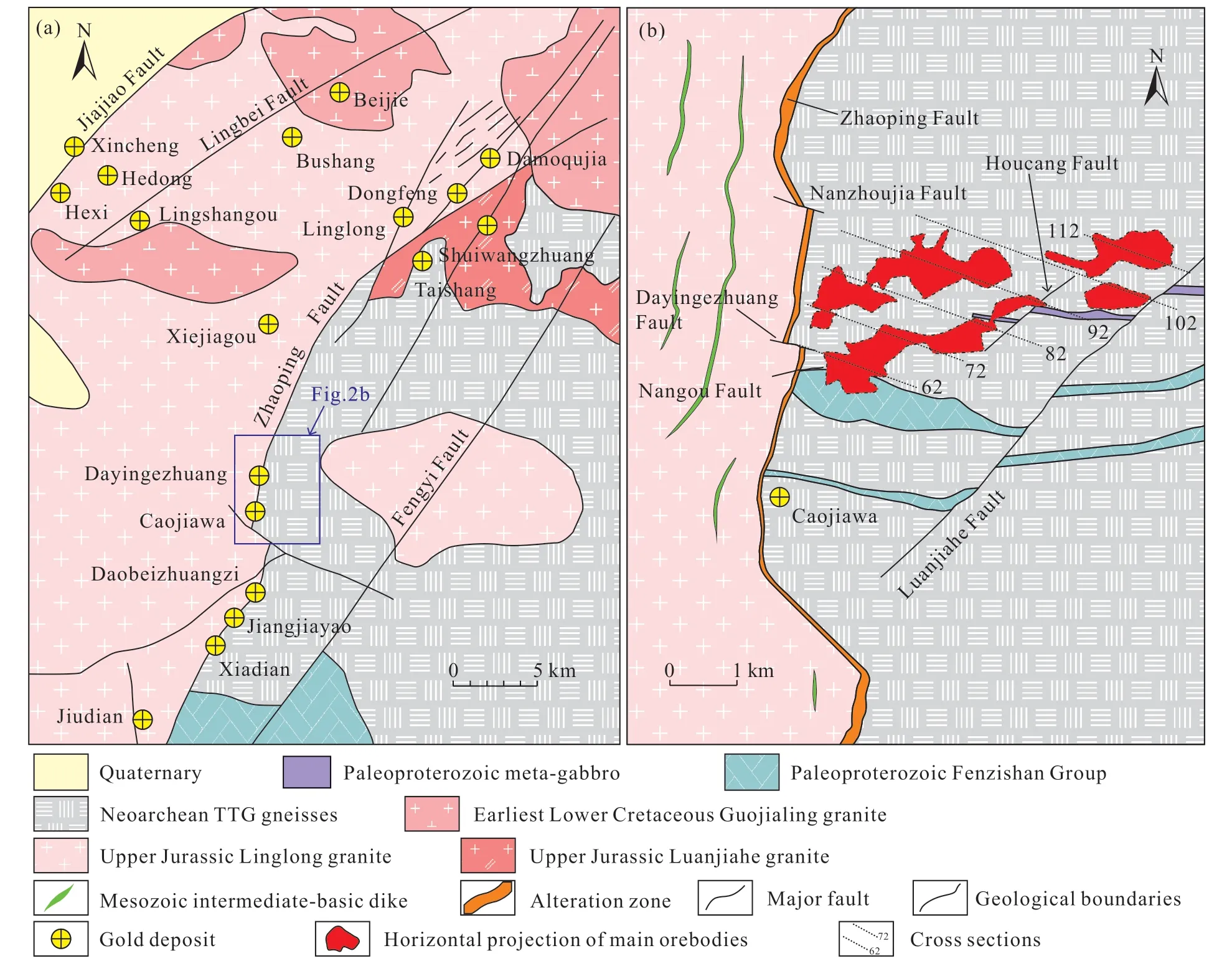
Fig. 2. a-Geological map of the Zhaoping gold belt; b-geological map of the Dayin’gezhuang gold deposit (modified from Liu XD, 2022).
As a major ore-controlling fault in the Jiaodong Peninsula,the Zhaoping Fault controls the Linglong, Dayin’gezhuang,Xiadian and Jiudian gold orefields from north to south, with cumulative proven gold reserves of more than 1000 t (Yu XF et al., 2018). This fault has a total length of 120 km, a width of 150-200 m, a dip direction of SE-E, and a dip angle of 30°-70°. In the Dayin’gezhuang gold deposit, the Zhaoping Fault has an outcrop length of approximately 6.8 km, a strike of 10°-20°, a dip direction of SE, and a dip angle of 10°-58°.This fault has a sharp dip angle in the shallow part, reaching more than 50° locally, and its dip angle gradually decreases to 10°-20° in the deep part. Therefore, the Zhaoping fault is a shovel-shaped fault with a steep upper part and a gentle lower part. The Zhaoping fault has a width of 40-80 m generally and up to 140 m on the surface. It widens toward the depth part, where it has a width of 50-150 m generally and a maximum of greater than 200 m. A continuous and stable major fracture plane has developed in the center part of the Zhaoping Fault and is marked by fault gouges with a thickness of 0.02-2.00 m. The two sides of the major fracture plane consist of cataclastic rocks with different fracture degrees, with early deformed mylonite residues visible locally under the major fracture plane. The Zhaoping Fault shows the characteristics of multiphase activities, including left-lateral transpressional motion before and after the mineralization and right-lateral transtensional motion during the mineralization(Lin WW et al., 2000). Moreover, this fault is cut by the Dayin’gezhuang and Nanzhoujia faults in the left-lateral direction.
3.2. Alteration types and alteration zones
The wall rocks of the Dayin’gezhuang gold deposit underwent extensive alterations, forming a large alteration zone and complete alteration types, which mainly include Kfeldspar alteration, silicification, sericitization, carbonatization,and chloritization (Zhang BL et al., 2017). Moreover,sericitization, silicification, and pyritization occur in combination, forming pyrite-sericite-quartz altered rock.
K-feldspar alteration (Figs. 3b, d) is a type of early hydrothermal alteration and is widely exposed far away from the major fracture plane. It has a width of up to 50-300 m,and its alteration intensity gradually weakens with an increase in the distance from ore-controlling structures. Pyrite-sericitequartz alteration (Figs. 3a, c, f) is a predominant type of alteration. It is closely related to mineralization and is frequently associated with disseminated fine-grained pyrites,with coarse-grained pyrites occasionally visible. Pyritesericite-quartz alteration tends to gradually weaken toward both sides with the major fracture plane as the center and is stronger on the footwall than on the hanging wall.Carbonatization is often interspersed in rocks in the form of veins and stockworks. Carbonatization is more developed on the hanging wall. Chloritization is mainly distributed on the hanging wall and the local fracture plane of the footwall.
The hydrothermal alteration in the Dayin’gezhuang gold deposit shows significant zoning and gradually weakens toward both sides from the major fracture plane. Weak sericitization and chloritization zones are commonly visible on the hanging wall, which features weak alteration and mineralization in general. Therefore, large-scale industrial orebodies rarely occur on the hanging wall. The alteration zones on the footwall include a pyrite-sericite-quartz altered cataclastic rock zone, a pyrite-sericite-quartz altered granitic cataclastic rock zone, a pyrite-sericite-quartz altered granite zone, a normal Linglong granite zone outward from the major fracture plane. These alteration zones gradually transition from one to another (Fig. 4).
3.3. Orebodies and resources
More than 200 gold orebodies have been defined in the Dayin’gezhuang gold deposit. Based on their occurrence locations and geological characteristics, these orebodies can be divided into No. 1 orebodies which are located to the south of the Dayin’gezhuang fault, and No. 2 orebodies which are located to the north of the Dayin’gezhuang fault, respectively(Fig. 2b).
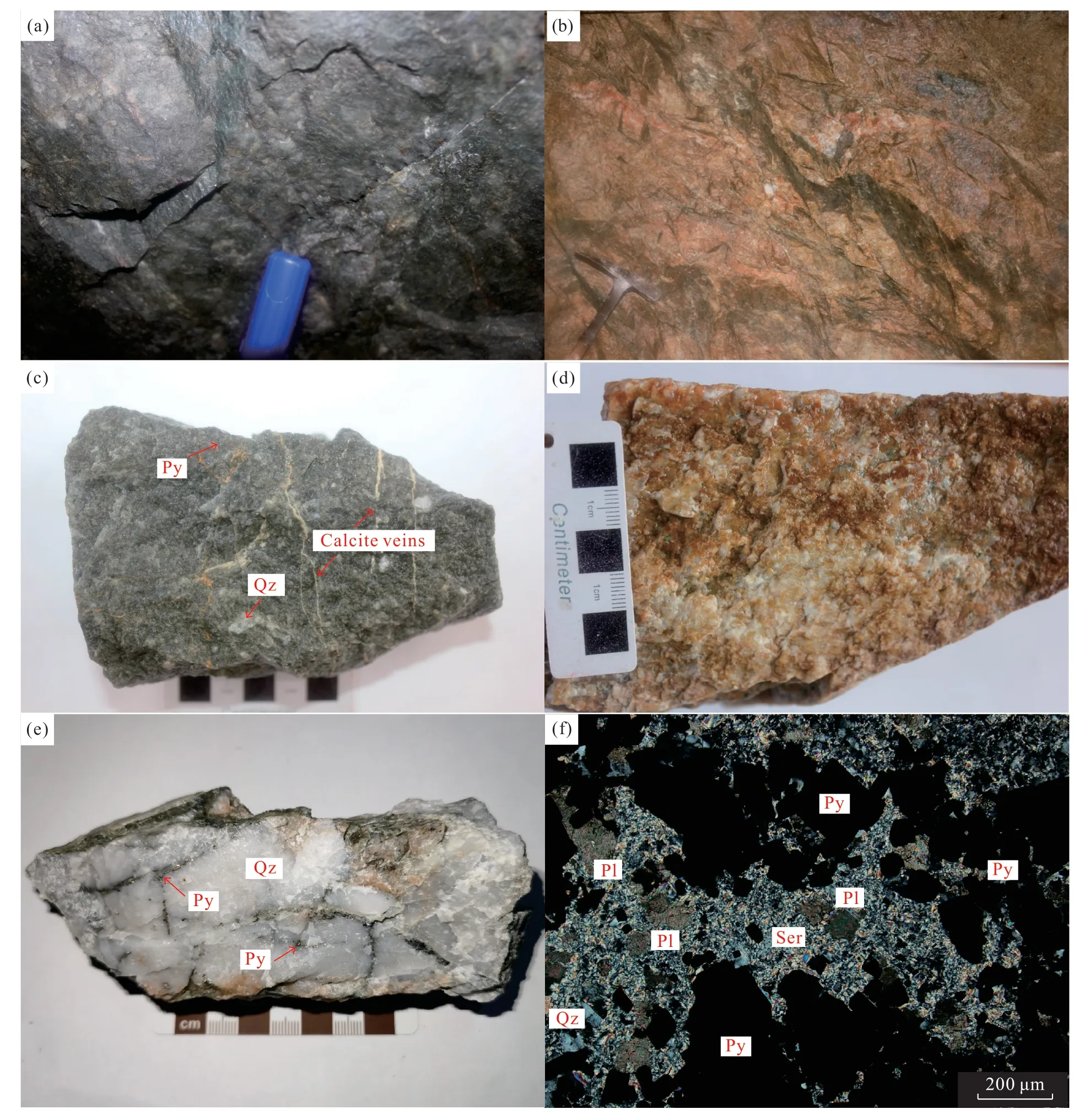
Fig. 3. Photographs (a-e) and photomicrographs (f) of typical hydrothermal alteration in the Dayin’gezhuang gold deposit. a-pyrite-sericitequartz alteration; b-K-feldspar alteration; c-pyrite-sericite-quartz altered sample cut by calcite veins; d-K-feldspar alteration sample; e-pyrite veins cut silicified sample; f-typical pyrite-sericite-quartz alteration. Pl-plagioclase, Py-pyrite, Qz-quartz, Ser-sericite.

Fig. 4. Comprehensive schematic diagram of lithologic zoning of the hydrothermal alteration zones and fractured zones in the Dayin’gezhuang gold deposit.
The No. 1 orebodies mainly occur in the shape of irregular large veins in the pyrite-sericite-quartz altered cataclastic rocks on the footwall of the major fracture plane. They are distributed in a gentle wave pattern along their strike and dip direction, with branches and combination as well as swelling and shrinkage (Fig. 5). They have simple morphologies and stable distribution, and have a strike of 2°-30° (average: 20°),a dip direction of SE, and a dip angle of 12°-42° (average:33°). The occurrence of the orebodies becomes increasingly gentle from shallow to deep. The No. 1 orebodies are located at an elevation of +24 - -1750 m and have a maximum length of 1229 m along their strike and a maximum length of 1236 m along their dip direction. The thickness of single-drillingcontrolled orebody is 0.62-20.70 m overall, 2.24-15.90 m in general, and 5.30 m on average. The single-sample gold grade is 1.00-91.50 g/t, with an average of 3.07 g/t.
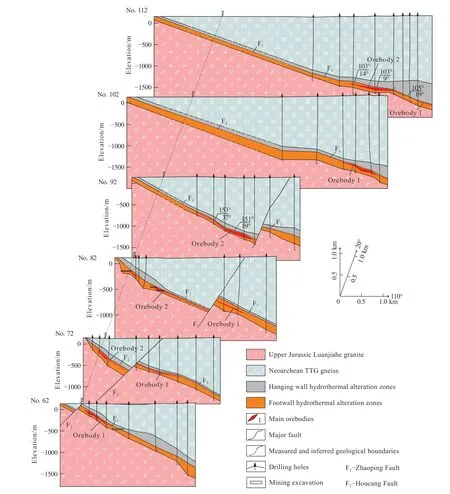
Fig. 5. Combined cross-sections of the Dayin’gezhuang gold deposit.
The No. 2 orebodies mainly occur in the shape of irregular large veins in the pyrite-sericite-quartz altered cataclastic rocks and locally extend into the pyrite-sericite-quartz altered granites on the footwall of the major fracture plane. They are distributed in a gentle wave pattern along their strike and dip direction, with branches and combination as well as swelling and shrinkage (Fig. 5). Their attitude are essentially consistent with that of the main fracture plane of the Zhaoping fault,with a strike of 1°-26°, a dip direction of SE, and a dip angle of 18°-51° (average: 39°). The No. 2 orebodies are located at an elevation of -28 - -1933 m and have a maximum length of 1057 m along the strike and a maximum length of 1450 m along the dip direction. The thickness of single-drillingcontrolled orebody is 0.64-75.07 m overall, 5.19-40.94 m in general, and 7.16 m on average. The single-sample gold grade is 1.00-66.30 g/t overall, 1.00-4.00 g/t in general, and 3.02 g/t on average.
The orebodies in the Dayin’gezhuang gold deposit have a pitch direction of NNE, a pitch angle of approximately 55°, a plunge direction of NEE 75°, and a plunge angle of approximately 22° overall (Fig. 6).
The shallow (-800-0 m) ore bodies are mainly controlled by tunnels and intensive drilling holes, while the deep (-2000 --800 m) orebodies are mainly controlled by drilling holes(Fig. 6b). The basic engineering spacing to explore the controlled resources is 120 m × 120 m (strike × dip direction).In fact, the proven resources, controlled resources and inferred resources have been explored in different ore blocks individually, with drilling spacing used including (29-108) m ×(38-92) m, (68-129) m × (90-135) m, and (118-244) m ×(186-292) m (strike × dip direction). The cumulative resources of gold ores and gold of all ore blocks are 68×106t and 183 t, respectively, with an average orebody thickness of 9.84 m and an average gold grade of 2.69 g/t. Among them,43×106t of gold ores and 118 t of gold are obtained from shallow orebodies, with an average orebody thickness of 10.25 m and an average gold grade of 2.75 g/t. Meanwhile,25×106t of gold ores and 65 t of gold are obtained from deep orebodies, with an average orebody thickness of 6.15 m and an average gold grade of 2.61 g/t. The gold resources ratio,ore grade ratio, and orebody thickness ratio between deep and shallow orebodies are 0.55, 0.95 and 0.60, respectively.Therefore, the scale and enrichment degree of deep orebodies are both smaller than those of shallow orebodies.es.es.es.
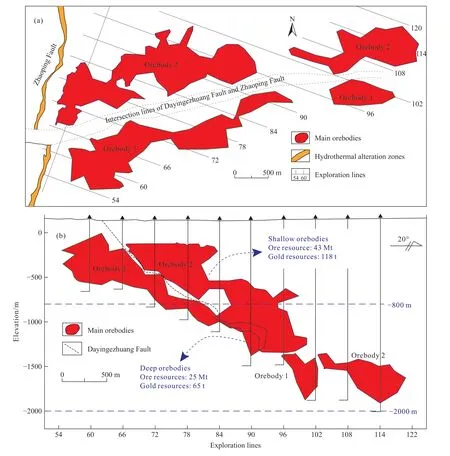
Fig. 6. a-Vertical projection diagram; b-horizontal projection diagram of the main orebodies in the Dayin’gezhuang gold deposit.
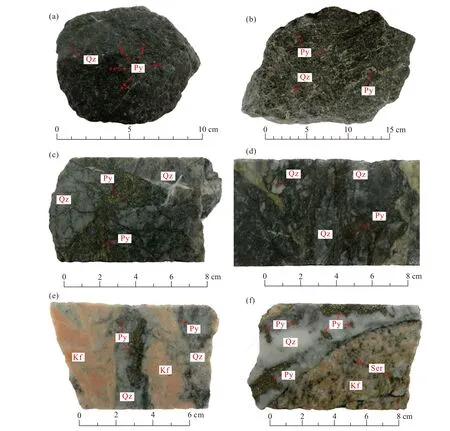
Fig. 7. Main gold ore types in the Dayin’gezhuang gold deposit. a-b-disseminated and veinlet-stockwork pyrite-sericite-quartz alterated cataclastic rock type; c-d-veinlet-stockwork pyrite-sericite-quartz alterated granite cataclastic rock type; e-f-veinlet-stockwork K-feldspar and pyrite-sericite-quartz alterated alteration granite type. Kf-K-feldspar; Py-pyrite; Qz-quartz; Ser-sericite.
3.4. Ore characteristics
There are mainly three types of ores in the Dayin’gezhuang gold deposit, namely fine-grained disseminated pyrite-sericite-quartz altered cataclastic rocks (Figs. 7a, b),disseminated and veinlet-stockwork pyrite-sericite-quartz altered granitic cataclastic rocks (Figs. 7c, d), and veinletstockwork pyrite-sericite-quartz altered granites (Figs. 7e, f),which are mainly distributed in the pyrite-sericite-quartz altered cataclastic rocks zone, the pyrite-sericite-quartz altered granitic cataclastic rocks zone, and the pyrite-sericite-quartz altered granite zone on the footwall of the major fracture plane respectively. Gold ores are composed of metallic minerals and non-metallic mineral. The primary metal mineral is pyrite, and the secondary ones are chalcopyrite, galena,sphalerite and argentite, whereas non-metallic minerals are dominated by quartz, sericite, K-feldspar and plagioclase,with a small quantity of biotite and calcite (Table 1). Among them, pyrite is the main gold-bearing mineral, followed by quartz. The ore textures are dominated by granular texture,followed by cataclastic, interstitial, etching, poikilitic, and opaque textures. The ore structures are dominated by disseminated and veinlet disseminated structures, followed by spotted, stockwork, and staggered structures.
According to the whole-rock analysis results of seven ore samples (Table 2), the SiO2content is high (66.20%-72.64%),with an average of 68.66%. The Al2O3content is 12.24%-14.41%, with an average of 13.72%. The ores also contain a small amount of K2O (3.82%-5.62%, average 4.73%), Fe2O3(1.42%-3.87%, average 2.46%), FeO (1.22%-4.35%, average 2.51%), CaO (0.30%-3.66%, average 1.94%), MgO (0.18%-1.36%, average 0.73%). The contents of TiO2, P2O5, MnO and Na2O are very low.

Table 1. Mineral composition of ores in the Dayin’gezhuang gold deposit.
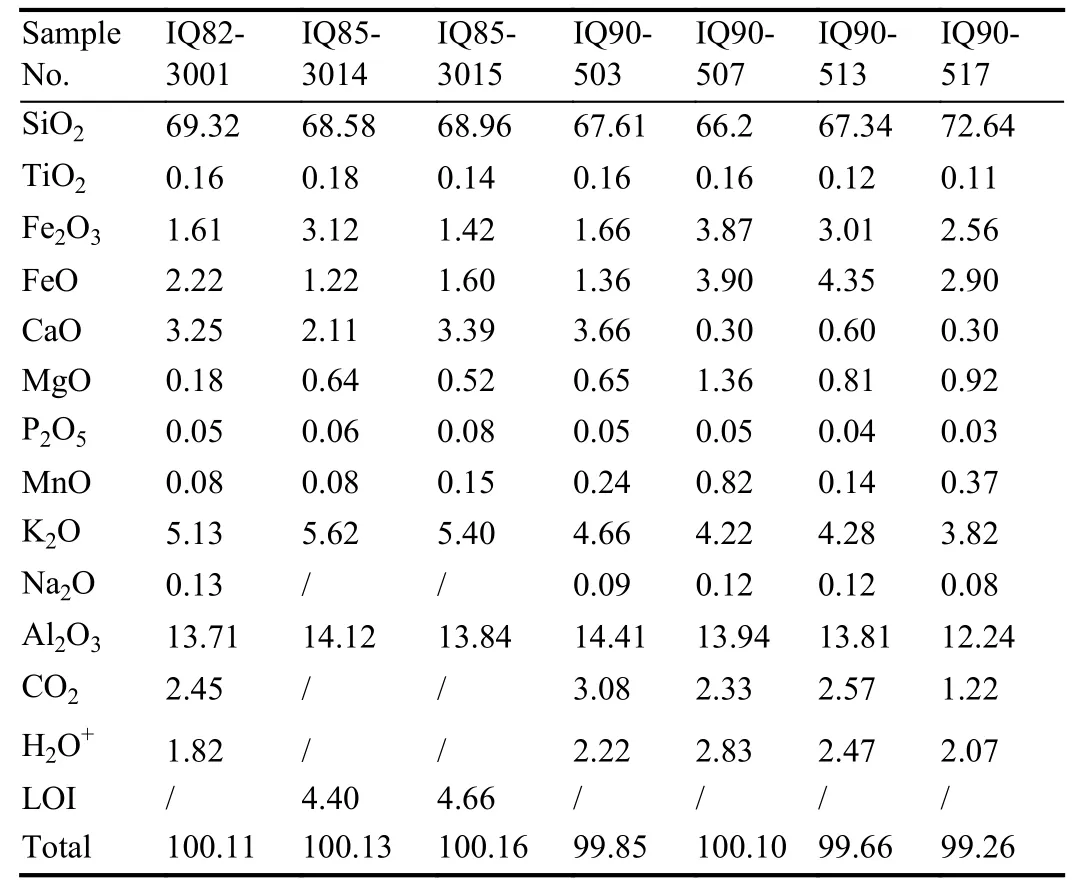
Table 2. Major elements (%) composition of ores in the Dayin’gezhuang gold deposit.

Table 3. Trace elements composition of ores in the Dayin’gezhuang gold deposit.
The primary useful element in the ores is Au, and the associated beneficial elements include Ag, S, Cu, Pb, and Zn,and the hazardous element is As. According to the whole-rock analysis results of 516 ore samples (Table 3), the Au grade ranges from 1.00g/t to 91.50 g/t, with an average of 2.58 g/t.The Ag grade ranges from 0.01 g/t to 153.54 g/t, with an average of 11.10 g/t, which can be used as an associated beneficial component for comprehensive recycling. The contents of other elements such as S, Cu, Pb and Zn are less,not up to the standard of comprehensive utilization. The content of hazardous element As is very low, with an average of 0.02% (0.01%-0.06%).
3.5. Characteristics of gold minerals
The gold minerals in the Dayin’gezhuang gold deposit mainly include electrum (Figs. 8e, f; 68.2%), followed by native gold (31.7%). The fineness of electrum and native gold is 563-799 (average: 722) and 811-917 (average: 881),respectively. The gold minerals mainly include fine grains(0.037-0.01 mm; 39.36%) and micrograins (<0.01 mm;38.67%) in terms of grain size and are mainly granular(72.32%) in shape. Based on their occurrence states, the gold minerals mainly include the intergranular type (Figs. 8a, c;60.18%), followed by the fissure type (20.37%) and the inclusion type (Figs. 8b, d; 19.45%).
3.6. Ore-forming stages
The Dayin’gezhuang gold deposit has four ore-forming stages according to mineral assemblages, textures, structures,and the crosscutting relationships of hydrothermal veins (Fig.9; Yang LQ et al., 2009; Chai P et al., 2019a, 2019b). Stage I is the pyrite-quartz stage. The hydrothermal veins of this stage are white and primarily consisted of quartz and a small number of pyrites and sericites. Stage II is the gold-quartzpyrite stage. The mineralized veins of this stage are grayishyellow and distributed as veinlets in fractured zones. They mainly consist of pyrites and a small amount of quartz,sericites, native gold, and electrum. Stage III is the goldquartz-polymetallic sulfide stage. The mineralized veins of this stage are grayish-yellow and are distributed as veinlets and micro-veins in fractured zones. They mainly consist of quartz, pyrites, chalcopyrite, galena, and sphalerite and a small amount of electrum, kustelite, pyrrhotite, tetrahedrite,galenobismuthite, and native bismuth. Stage IV is the quartzcarbonate stage. The hydrothermal veins of this stage are distributed as veins and veinlets in fractured zones. They mainly consist of calcites and a small amount of quartz.
The mineralization intensity evolved from weak to strong and then weak from early to late ore-forming stages. The mineral assemblages evolved from simple to complex and then simple. They transitioned from only pyrites to the coexisting of galena, sphalerite, pyrites, and finally carbonate veins. Gold was mainly precipitated in ore-forming stages II and III.
4. Ore deposit geochemistry
4.1. Fluid inclusions
The fluid inclusions in the Dayin’gezhuang gold deposit generally have a small diameter of 2-15 μm and various morphologies, such as the oval, strip, and negative crystal.They mainly have three types, i.e., H2O-CO2, H2O solution,and pure CO2(Fig. 10). The H2O-CO2inclusions are the most important and are three-phase(LH2O+LCO2+VCO2)ortwo-phase(LH2O+LCO2/VCO2) at room temperature(25°C).The y can be subdivided into H2O-rich (LCO2±VCO2<50%)and CO2-rich(LCO2±VCO2>50%) subtypes according to the proportion of the volume of the CO2phases (LCO2±VCO2)in the total inclusion volume.The H2O solution inclusions are two-phase(LH2O+VH2O)at room temperature,and their gas-liquid ratio is generally 10%-60%, with a maximum of up to 90%. The pure CO2inclusions are two-phase or single-phase (LCO2±VCO2) at room temperature.

Fig. 8. Photomicrographs (a-d) and backscattered electron images (e, f) of typical gold ores in the Dayin’gezhuang gold deposit. Ccp-chalcopyrite; Ele-electrum; Gal-galena; Gl-native gold; Py-pyrite, Qz-quartz.

Fig. 9. Paragenetic sequence of main minerals in the Dayin’gezhuang gold deposit (modified from Yang LQ et al., 2009; Chai P et al., 2019a,2019b).

Fig. 10. Photomicrographs of typical fluid inclusions in the Dayin’gezhuang gold deposit. a- aqueous type (H2O-NaCl) inclusions and pure carbonic type (CO2) inclusions; b-aqueous type (H2O-NaCl) inclusions and aqueous-carbonic type (CO2-H2O-NaCl) inclusions; c-aqueous type (H2O-NaCl) inclusions; d-aqueous-carbonic type (CO2-H2O-NaCl) inclusions; e-aqueous type (H2O-NaCl) inclusions; f-aqueous-carbonic type (CO2-H2O-NaCl) inclusions.
The vapor-phase components of H2O-CO2inclusions mainly include CO2and a small amount of CH4, C2H6, H2S,SO2, N2, and CO, and their liquid-phase components mainly include H2O (Shen K et al., 2000; Liu Y et al., 2014; Chai P et al., 2019a, 2019b). The pure CO2inclusions mainly include CO2and a small amount of CH4(Chai P et al., 2019a, 2019b).The H2O solution inclusions are mainly composed of H2O(Chai P et al., 2019a, 2019b).
The commonly visible inclusions formed at ore-forming stage I include H2O-CO2and pure CO2inclusion assemblages.TheTm-CO2rangesbetween-58.4°Cand-56.6°C, whichisslightlylower than the triplepoint temperature of pure CO2(-56.6°C), indicating that the CO2phase in the H2O-CO2inclusions may contain a trace amount of CH4or other vapor-phase components. TheTm-clathrange between 5.3°Cand7.8°C,andTh-CO2rangeis12.1-30.9°C,andTh-TOTrange is305-388°C. The salinity ranges from
4.28% NaCl eqv to 8.51% NaCl eqv (Table 4; Fig. 11).
The inclusions formed at ore-forming stage II include the coexisting of H2O-CO2, pure CO2, and H2O solution inclusions. TheTm-CO2ranges from -58.1 to -56.6°C,suggesting the CO2phase in the H2O-CO2inclusions may contain a trace amount of CH4or other vapor-phase components. TheTm-clathis between 6.0 and 8.7°C. TheTh-CO2ranges between 24.3 and 29.8°C. TheTh-TOTis 235-317°C.The salinity ranges between 2.62% and 7.40% NaCl eqv. The H2O solution inclusions have aTm-iceof -7.6 - -0.9°C, aTh-TOTof 235-317°C, and salinity of 1.56%-11.12% NaCl eqv(Table 4; Fig. 11).
Similar to stage II, the inclusions formed at ore-forming stage III also include the coexisting of H2O-CO2, pure CO2,and H2O solution inclusions, except that the proportion of the H2O solution inclusions increases significantly. TheTm-CO2ranges from -58.6°C to -56.6°C, suggesting that the CO2phase still contains a trace amount of CH4or other vaporphase components. TheTm-clathranges between 5.9°C and 8.4°C. TheTh-CO2ranges from 21.0°C to 29.8°C. TheTh-TOTmainly ranges between 236°C and 319°C. The salinity ranges from 3.19% to 7.51% NaCl eqv. For H2O solution inclusions,theTm-iceranges between -9.4°C and -1.6°C. TheTh-TOTranges from 195°C to 287°C. The salinity ranges from 2.73%to 13.33% NaCl eqv (Table 4; Fig. 11).

Fig. 11. Histograms of total homogenization temperatures (Th-TOT) and salinities of fluid inclusions in different stages.

Table 4. Summary of the microthermometric data for fluid inclusions trapped in quartz and calcite from four mineralization stages.
The inclusions formed at ore-forming stage IV mainly include H2O solution inclusions, which have aTm-iceof -4.2 --1.1°C, aTh-TOTof 126-233°C primarily, and salinity of 0.48%-6.72% NaCl eqv (Table 4; Fig. 11).
4.2. H and O isotopes
TheδDSMOW-quartzvalues range from -99.71‰ to -68.38‰(average: -77.16‰;n=26) andδ18OSMOW-quartzvalues range from 7.34 ‰ to 12.66 ‰ (average: 10.38 ‰;n=26). TheδDSMOW-quartzandδ18OSMOW-quartzvalues of different oreforming stages are slightly different (Table 5). The hydrothermal quartz of ore-forming stage I hasδDSMOW-quartzvalues of-84.41 ‰ - -68.38 ‰ (average: -75.71 ‰;n=7) andδ18OSMOW-quartzvalues of 7.34‰-12.66‰ (average: 10.55‰;n=7). The hydrothermal quartz of ore-forming stage II hasδDSMOW-quartzvalues of -79.20 ‰ - -69.83 ‰ (average:-73.74‰;n=7) andδ18OSMOW-quartzvalues of 7.34‰-11.81‰(average: 10.47‰;n=7). The hydrothermal quartz of oreforming stage III hasδDSMOW-quartzvalues of -81.38‰ --70.40‰ (average: -76.07‰;n=6) andδ18OSMOW-quartzvalues of 7.34‰-11.81‰ (average: 10.13‰;n=6). The hydrothermal quartz of ore-forming stage IV has theδDSMOW-quartzvalues of-99.71 ‰ - -78.71 ‰ (average: -83.93 ‰;n=6) andδ18OSMOW-quartzvalues of 7.34‰ -11.81‰ (average: 10.31‰;n=6).
The hydrogen isotope value of hydrothermal quartz(δDSMOW-quartz) represents the hydrogen isotope value of fluid(δDSMOW-water), but the oxygen isotope value of fluid(δ18OSMOW-water) should be calculated based on the oxygen isotope values of hydrothermal quartz (δ18OSMOW-quartz) and the corresponding metallogenic temperatures of different oreforming stages. The calculation equations (Clayton RN et al.,1972) are as follows:

In general, the total homogenization temperature of fluid inclusions represents the lower limit of the trapping temperature. However, significant fluid immiscibility occurred in ore-forming stages II and III of the Dayin’gezhuang gold deposit. Therefore, the total homogenization temperature of fluid inclusions can approximately represent the metallogenic temperature (Hagemann SG and Lüders V,2003). Based on the microthermometry of the abovementioned fluid inclusions, the metallogenic temperatures of the Dayin’gezhuang gold deposit at oreforming stages I-IV were 340°C, 280°C, 250°C, and 200°C,respectively.
As indicated by the calculation results (Table 5), the oreforming fluids in the Dayin’gezhuang gold deposit haveδDSMOW-watervalues of -99.71 ‰ - -68.38 ‰ (average:-77.16‰;n=26) andδ18OSMOW-watervalues of -4.36‰-7.07‰(average: 2.05 ‰;n=26). The ore-forming fluids of ore-forming stage I haveδDSMOW-watervalues of -84.41‰ --68.38‰ (average: -75.71‰;n=7) andδ18OSMOW-watervalues of 1.75‰-7.07‰ (average: 4.96‰;n=7). The ore-forming fluids of ore-forming stage II haveδDSMOW-watervalues of-79.20 ‰ - -69.83 ‰ (average: -73.74 ‰;n=7) andδ18OSMOW-watervalues of -0.31‰-4.16‰ (average: 2.83‰;n=7). The ore-forming fluids of ore-forming stage III haveδDSMOW-watervalues of -81.38 ‰ - -70.40 ‰ (average:-76.07‰;n=6) andδ18OSMOW-watervalues of -1.61‰-2.86‰(average: 1.18‰;n=6). The ore-forming fluids of ore-forming stage IV haveδDSMOW-watervalues of -99.71‰ - -78.71‰(average: -83.93 ‰;n=6) andδ18OSMOW-watervalues of-4.36‰-0.11‰ (average: -1.39‰;n=6).
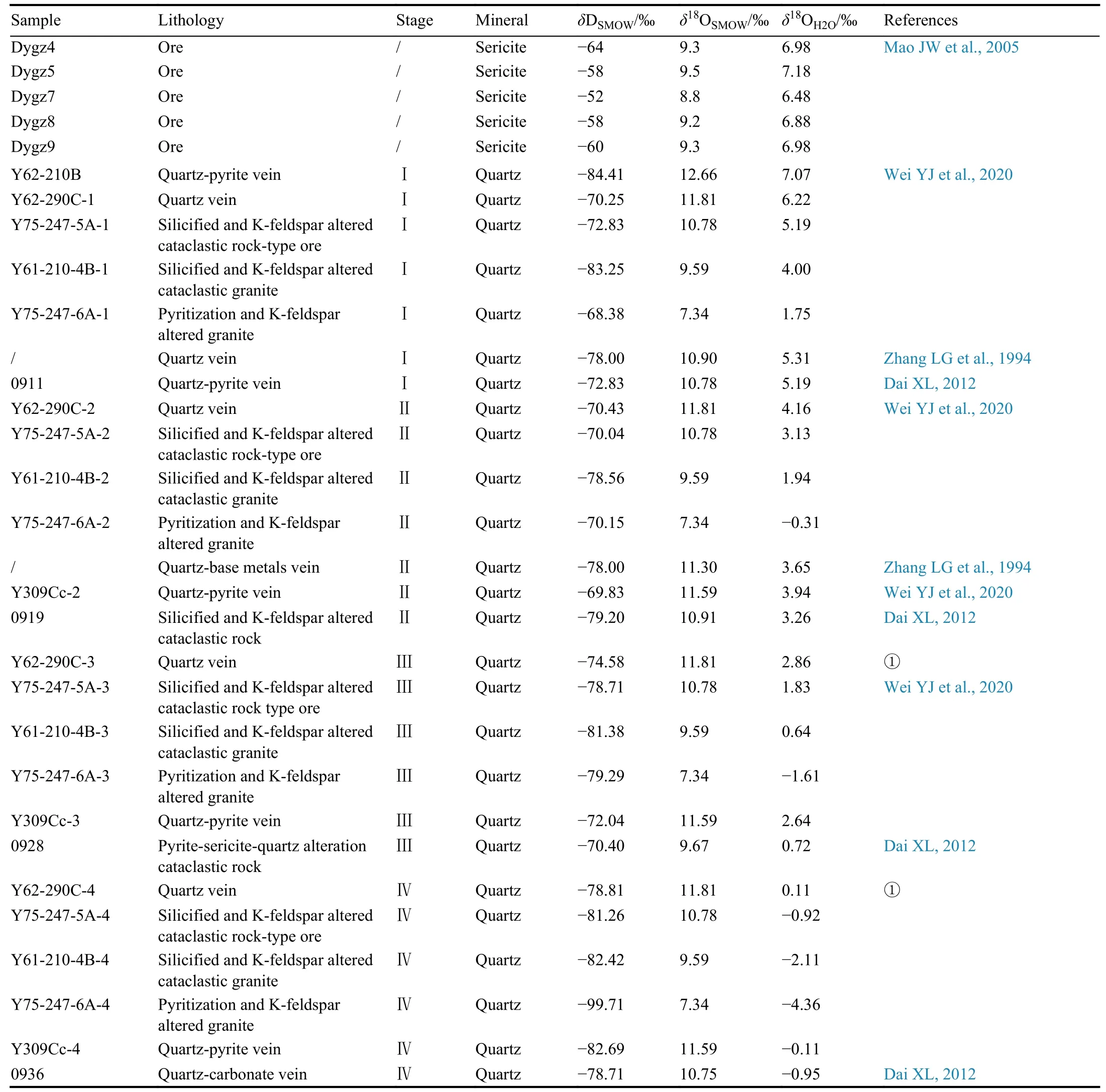
Table 5. Hydrogen and oxygen isotope compositions from four ore-forming stages in the Dayin’gezhuang gold deposit.
The hydrothermal sericites of ore-forming stages II and III in the Dayin’gezhuang gold deposit haveδDSMOW-sericitevalues of -64‰ - -52‰ (Table 2; average: -58‰;n=5) andδ18OSMOW-sericitevalues of 8.8‰-9.5‰ (average: 9.2‰;n=5).The hydrogen isotope value of hydrothermal sericites(δDSMOW-sericite) represents the hydrogen isotope value of fluids (δDSMOW-water). But the oxygen isotope value of fluids(δ18OSMOW-water) should be calculated according to the oxygen isotope values of hydrothermal sericites (δ18OSMOW-sericite) and the corresponding metallogenic temperatures at different oreforming stages. The calculation equations (Zheng YF and Chen JF, 2000) are as follows:

According to the calculation results, theδDSMOW-waterandδ18OSMOW-watervalues of ore-forming stages II and III are-64‰ - -52‰ (average: -58‰;n=5) and 6.48‰-7.18‰(average: 6.90‰;n=5), respectively.
4.3. S isotopes
The Dayin’gezhuang gold deposit hasδ34SCDTvalues(Table 6) of 4.6‰-9.0‰, with a range of 4.4‰ and an average of 6.9‰ (n=66). Specifically, theδ34SCDTvalues of ore-forming stage I are 5.8‰-9.0‰, with a range of 3.2‰and an average of 7.5‰ (n=21); those of ore-forming stage II are 4.8‰-8.0‰, with a range of 3.2‰ and an average of 6.6‰ (n=20), those of ore-forming stage III are 5.0‰-7.6‰,with a range of 2.6‰ and an average of 6.6‰ (n=14), and those of the ore-forming stage IV are 4.6‰-7.0‰, with a range of 2.4‰ and an average of 5.7‰ (n= 4).
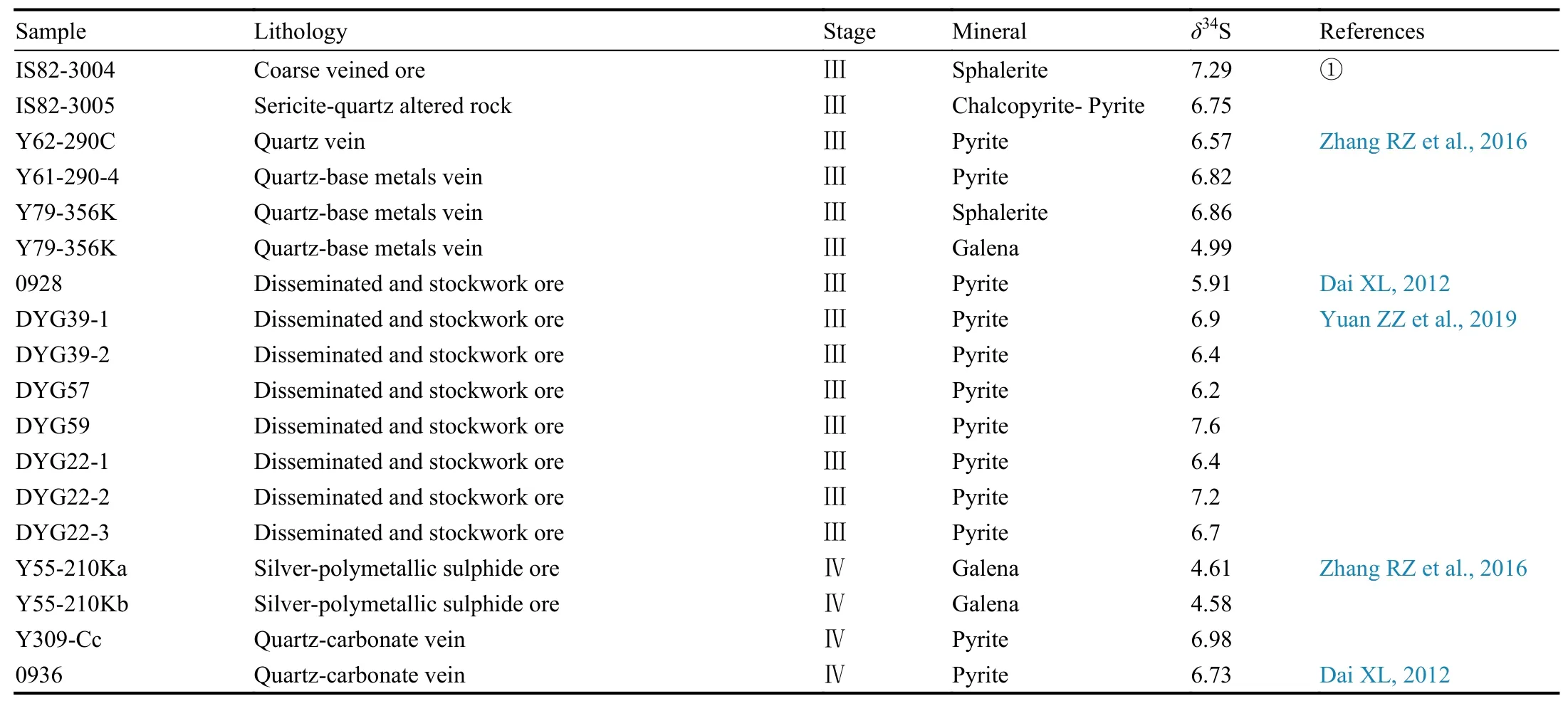
Table 6. (Continued)

Table 6. Sulfur isotope compositions from four ore-forming stages in the Dayingezhuang gold deposit.
4.4. Pb isotopes
The Pb isotopes of the Dayin’gezhuang gold deposit vary in a small range and have a relatively stable composition(Table 7). The206Pb/204Pb values are 17.1100-17.3585, with an average of 17.2731 (n=42), the207Pb/204Pb values are 15.4000-15.6116, with an average of 15.4815 (n=42), and the208Pb/204Pb values are 37.6000-38.3328, with an average of 37.9180 (n=42).

Table 7. Lead isotopic compositions of the Dayin’gezhuang gold deposit.
5. Discussion
5.1. Spatial coupling relationships between ore-controlling fault and orebodies
To analyze the deep occurrence characteristics of the orecontrolling Zhaoping Fault and the spatial coupling relationship between the fault and orebodies in detail, a threedimensional geological model of the Dayin’gezhuang gold deposit at an elevation of -2000-0 m was established based on drilling holes data and the data on exploration lines. Then,the fault slope is plotted using the information about the major fracture plane of the Zhaoping Fault extracted from the model(Fig. 12; Xie TC et al., 2022). As shown in the diagram, the dip angle of the fault is high in the shallow and gradually decreases towards the deep at an elevation of -2000-0 m.Moreover, the fault surface undulates significantly and presents a shovel-shaped stepped pattern overall. This plot also shows that there are three NNE-trending zones with a high dip angle (in red), between and besides which are zones with a low dip angle (in yellow and green), indicating that the fault dip angle presents three sections of stepped high-to-low transitions. The stepped characteristic of this fault is similar to that of the Sanshandao and Jiaojia faults, indicating that these three major ore-controlling faults (Sanshandao, Jiaojia, and Zhaoping faults) in the Jiaodong Peninsula have consistent morphological characteristics (Song MC et al., 2012, 2021b).Therefore, they should belong to the same fault system formed under a unified dynamic setting and are detachment faults developing between Precambrian metamorphic rocks and Jurassic granites (Song MC et al., 2022a).
To analyze the occurrence characteristics of the gold orebodies, the gold orebodies damaged by the Dayin’gezhuang and Houcang faults are restored and the thickness ×grade distribution map of major orebodies is plotted. As shown in the map, there are multiple mineralization enrichment areas with high thickness × grade values. These mineralization enrichment areas are distributed in a beaded pattern along the dip directions of the orebodies, roughly forming two near-parallel bead zones in the south and the north each. The general distribution direction of the bead zones indicates that the orebodies have a plunge direction of 75°. The mineralization enrichment areas are present as NNEtrending zones and show an alternating distribution with weakly mineralized zones (Fig. 13).
The map showing the main orebodies distribution and mineralization enrichment areas and the diagram presentingthe slope of the major fracture plane of the Zhaoping Fault are superimposed together, showing that the locations of mineralization enrichment areas are basically consistent with the steep-to-gentle transition parts of the fault surface’s slope and mainly occur at positions with a gentle fault dip angle(Fig. 12). This result indicates that the gold mineralization enrichment areas are mainly distributed in the transition parts of the fault dip angle and relatively gentle steps, forming a stepped pattern from shallow to deep.
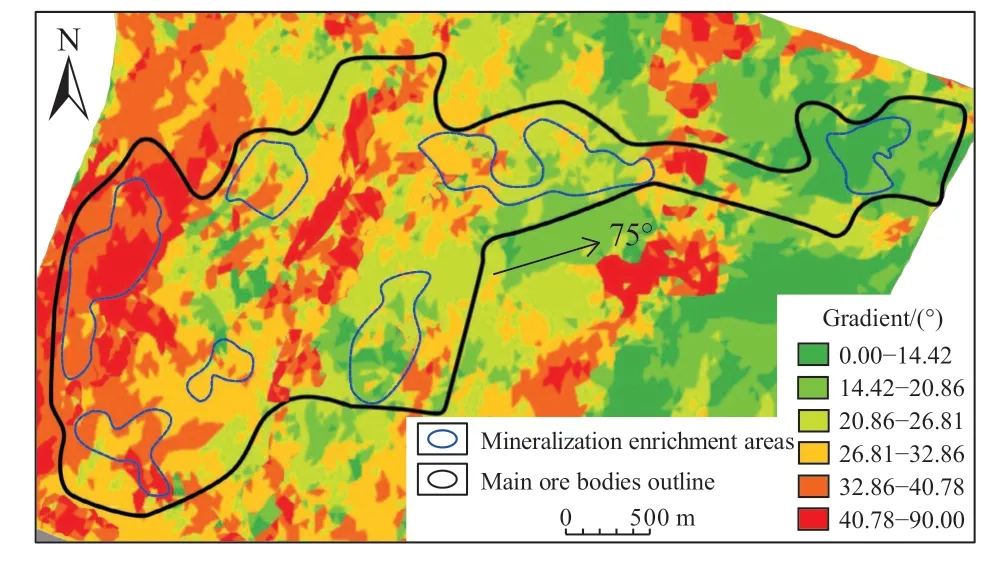
Fig. 12. Diagram showing the relationships between the fault dip angle and the mineralization enrichment areas of main orebodies along with the fault dip direction in the Dayin’gezhuang gold deposit (modified from Xie TC et al., 2022).
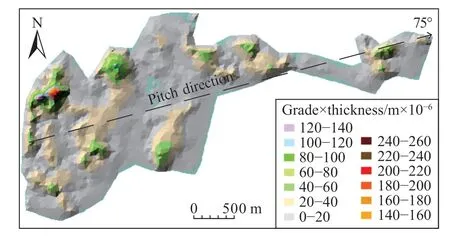
Fig. 13. Three-dimensional distribution maps of the thickness ×gold grade of main orebodies in the Dayin’gezhuang gold deposit(modified from Xie TC et al., 2022).
The above-mentioned pitch and plunge regularity and stepped pattern of orebodies are widely distributed in the Jiaodong area (Song MC et al., 2012, 2020b, 2022b; Li SY et al., 2022). The formation of the stepped pattern is related to the change in fluid pressure affected by the change in the fault dip angle. When fluids flew through the steep-to-gentle transition sections of a fault and migrated toward gently dipping sections, the pressure suddenly decreased, and the fluids began to flow in a nearly horizontal direction at a low flow velocity. All these created favorable conditions for fluid unloading and gold precipitation. The fault transitions along its strike and dip direction jointly control the pitch and plunge direction of gold orebodies (Song MC et al., 2022a). The stepped pattern and the pitch and plunge regularities of orebodies play an important role in deep orebodies prospecting. These occurrence patterns of gold orebodies have been applied to the deep orebodies prospecting of the Dayin’gezhuang gold deposit and the Sanshandao, Jiaojia, and Taishang-Shuiwangzhuang supergiant gold deposits.
5.2. Metallogenic epoch
The metallogenic age of the Jiaodong gold deposits has been determined to be 120±2 Ma (Deng J et al., 2020c; Zhang L et al., 2020). According to the testing results (Table 8) of the isotopic age of hydrothermal minerals in the Dayin’gezhuang gold deposit, the K-feldspars and sericites/muscovites have40Ar/39Ar ages of 118±1 Ma and (119.1±1.2)-(133.37±0.56) Ma, respectively. Different researchers provided different explanations for the metallogenic time of the gold deposit based on these results. Yang LQ et al. (2014a)believed that metallogenic events in the Dayin’gezhuang gold deposit occurred at 134-126 Ma. Yuan ZZ et al. (2019)determined the40Ar-39Ar age of sericites to be 119.1±1.2 Ma and the zircon U-Pb age of mafic dikes before metallogenic events to be 122.7±2.6 Ma. Therefore, they considered that the Dayin’gezhuang gold deposit had a metallogenic age of 119.1±1.2 Ma. Charles N et al (2013) determined the40Ar/39Ar plateau age of muscovites in Linglong granites on the footwall of the Zhaoping fault to be 133.98±1.47 Ma.They believed that this age resulted from the early ductile deformation of the Linglong detachment fault (the southern segment of the Zhaoping fault) and that the ductile and brittle deformation of the Linglong detachment fault lasted from 143 Ma to 128 Ma. Based on the above studies, the authors consider that the age of (133.37±0.56)-(126.8±0.59) Ma of the Dayin’gezhuang gold deposit may reflect the activity age of the detachment fault rather than the metallogenic age of the deposit. Given that the metallogenic characteristics of the Dayin’gezhuang gold deposit are consistent with those of other gold deposits controlled by the Zhaoping, Jiaojia, and Sanshandao fault zones, these gold deposits should have the same metallogenic age. Therefore, the authors of this paper consider that the isotopic age of 118-119.1 Ma mentioned above reflects the metallogenic age of the Dayin’gezhuang gold deposit.

Table 8. Metallogenic age of the Dayin’gezhuang gold deposit.
5.3. Properties and sources of ore-forming fluids
The ore-forming fluids in the Dayin’gezhuang gold deposit are generally of H2O-CO2-NaCl type with mediumlow temperature and medium-low salinity (Yang LQ et al.,2009; Shen K et al., 2000; Chai P et al., 2019a, 2019b). From the early ore-forming stage (I) to the late ore-forming stage(IV), the fluid inclusion types changed from simple to complex and then simple, and the fluids experienced a gradual evolution from high to medium and then low temperature.The salinity ranges of the main ore-forming stages (II and III)are significantly wider than those of the early and late oreforming stages (I and IV). The H2O-CO2and H2O solution inclusions were simultaneously trapped in the same fluid inclusion assemblages at the main ore-forming stages (Fig. 10a,b). However, the two types of inclusions have similar final total homogenization temperatures but different salinity values (H2O solution inclusions have high salinity and H2OCO2inclusions have low salinity; Fig. 14), indicating that significant fluid immiscibility occurred at the main oreforming stages (Ramboz C et al., 1982; Roedder E, 1984),resulting in contents of volatile constituents such as CO2and H2S in fluids reduced and the gold-bearing complexes decomposed, which led to gold precipitation and mineralization (Bowers TS and Helgeson HC, 1983; Phillips GN and Evans KA, 2004; Chi GX and Xue CJ, 2011; Chai P et al., 2019a).
Many studies have been conducted on the characteristics of ore-forming fluids in the Jiaodong gold deposits, but the sources of ore-forming fluids in these deposits are still controversial. Many researchers believe that the ore-forming fluids were dominated by magmatic water at the main oreforming stages and were then mixed with meteoric water in the late ore-forming stage (Deng J et al., 2015; Li L et al.,2015; Wen BJ et al., 2016; Liu JC et al., 2017; Cai YC et al.,2018). Some researchers believe that metamorphic water may be the main source of ore-forming fluids in the Jiaodong gold deposits and may be mixed with magmatic water and meteoric water (Yang LQ et al., 2014b, 2016, 2017). Some researchers denied the influence of meteoric water on gold mineralization in the Jiaodong area and believed that the H-O isotopic characteristics are the result of the influence of secondary inclusions after mineralization (Goldfarb RJ and Groves DI,2015). A few of the H-O isotope values of quartz and sericites in the ores of the Dayin’gezhuang gold deposit fell in the zones of primary magmatic water, metamorphic water, and mantle water, while most of them fell between the zone of Mesozoic meteoric water in the Jiaodong area and the zone of primary magmatic water, metamorphic water, or primary mantle water. The H-O isotopic values of quartz at stage I fell in and near the zones of primary mantle water and primary magmatic water, while those of sericites at stage II/III fell in the zones of primary magmatic water and metamorphic water.Moreover, the H-O isotopic composition gradually drifted to meteoric water from stage I to stage IV (Fig. 15). Considering that the Jiaodong Group has a metamorphic age of approximately 1.8-1.7 Ga (Faure M et al., 2003), which is far earlier than the metallogenic age, the ore-forming fluids unlikely originated from the metamorphic water of the Jiaodong Group. Moreover, this conclusion is also supported by the fact that no metamorphic event occurred in the Dayin’gezhuang mining area during the metallization. Therefore, the fluids in the early ore-forming stage might be magmatic water or mantle water, and then meteoric water gradually entered the ore-forming fluids in the late ore-forming stage.
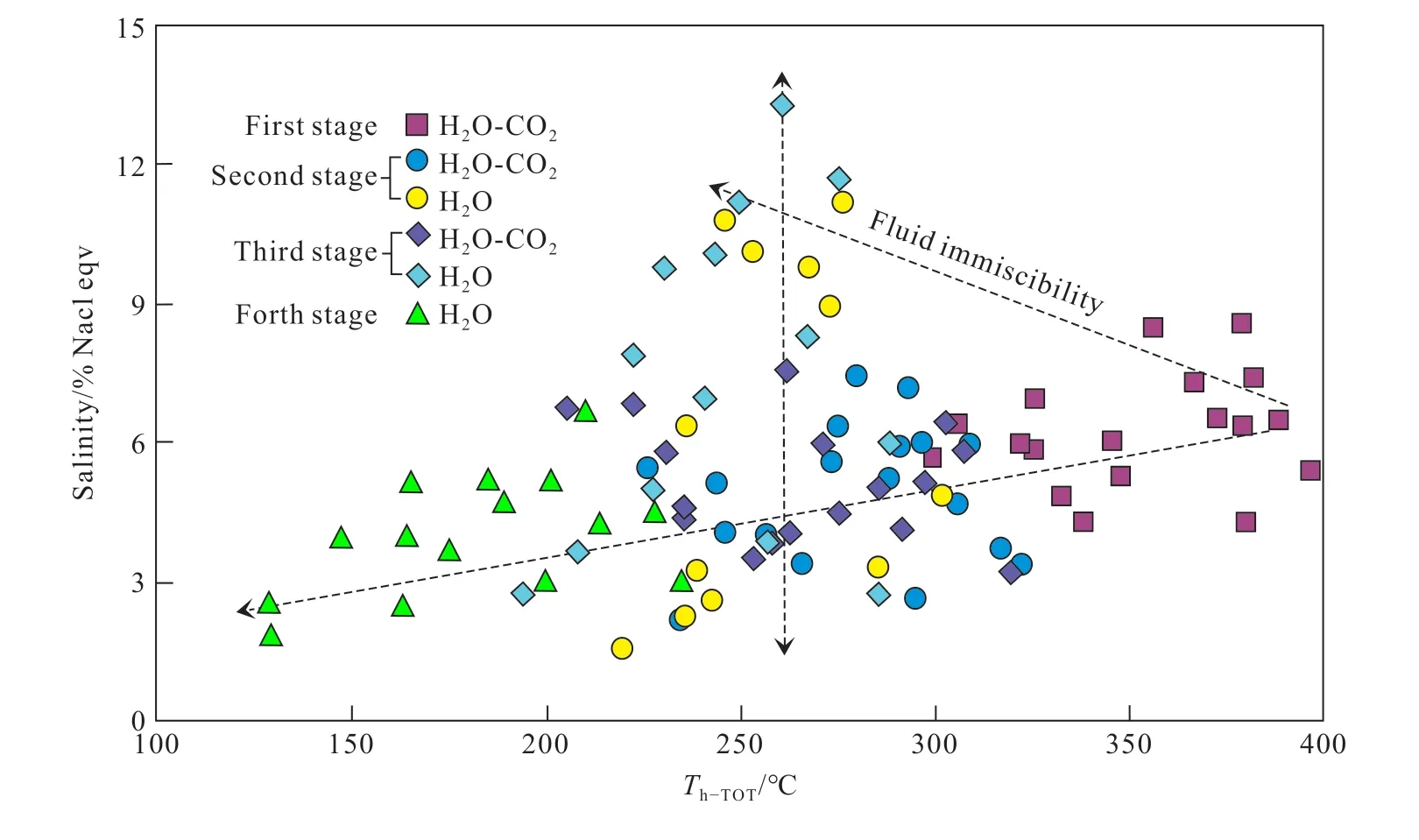
Fig. 14. Plots of total homogenization temperature (Th-TOT) vs salinity of fluid inclusions from the Dayin’gezhuang gold deposit. Data source:Chai P et al., 2019a, 2019b; Dai XL, 2012.
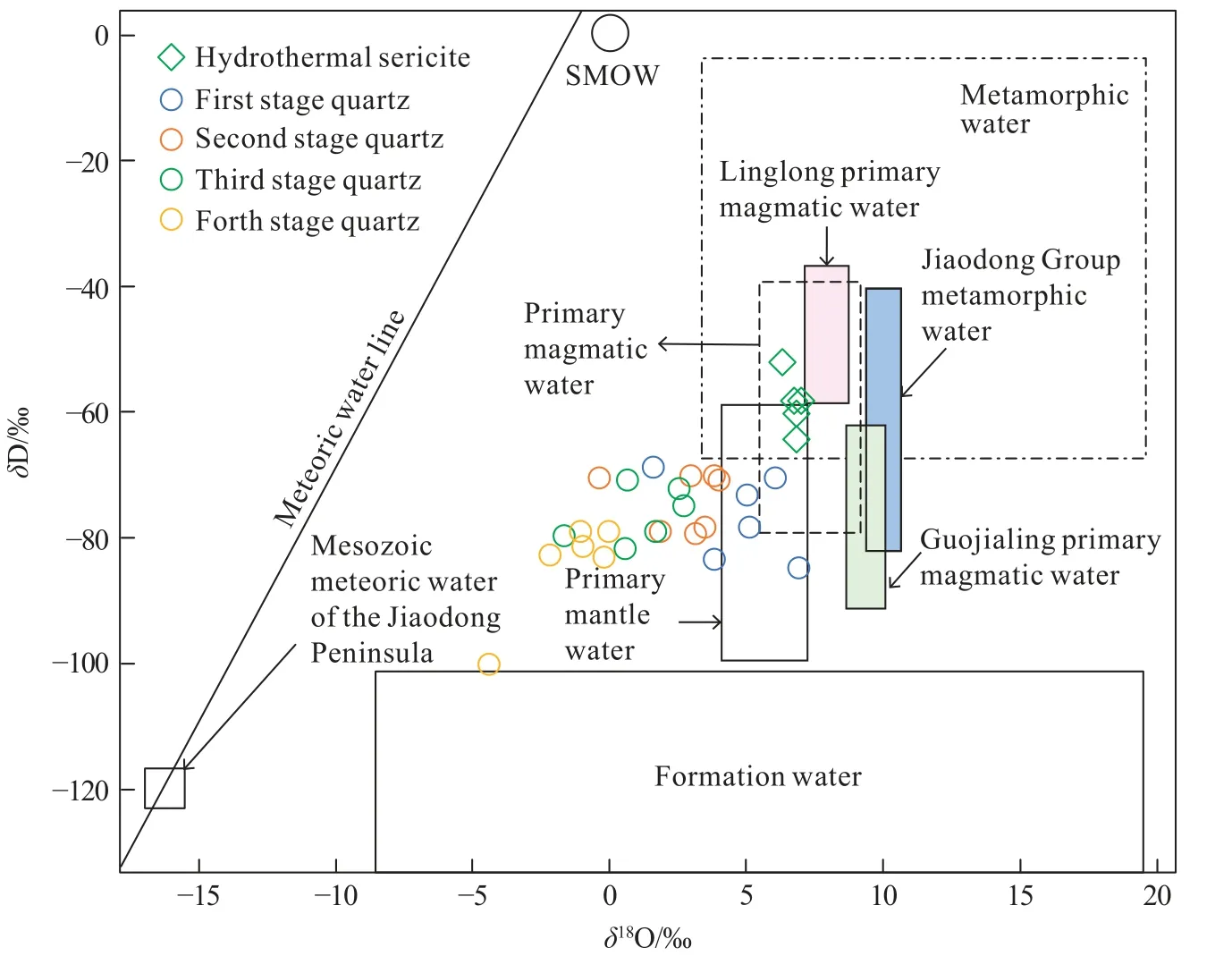
Fig. 15. δD vs. δ18O diagram of ore-forming fluids in the Dayin’gezhuang gold deposit (base map from Sheppard SMF, 1996). References are given in Table 5. Fields for Mesozoic meteoric water of the Jiaodong Peninsula, Linglong and Guojialing primary magmatic water, and Jiaodong Group metamorphic water are from Zhang LG et al., 1994, 1995; Mao JW et al., 2005.
According to the aforementioned characteristics of fluid inclusions in the Dayin’gezhuang gold deposit, the authors hold that the ore-forming fluids of this deposit originate from mixed sources. Specifically, the early fluids may come from the magmatic fluid system in the process of crust-mantle interactions, and the late fluids may be mixed with much meteoric water. Large-scale magmatism occurred in the Jiaodong area during the gold mineralization of the Dayin’gezhuang gold deposit, forming the Guojialing and Weideshan granites originating from the mixing crust-mantle source, mantle-derived lamprophyres, and the Liulinzhuang high-magnesium diorites originating from of differentiation of mantle-derived materials (Song MC et al., 2020a, 2020b;Wang B et al., 2021). This result indicates that the gold metallogenic period of the Dayin’gezhuang gold deposit was just a period of strong crust-mantle interactions.
5.4. Sources of ore-forming minerals
There are still different understandings of the sources of ore-forming materials in the Jiaodong gold deposits.Researchers holding the view of crust-derived ore-forming materials believe that the metals originate from the Precambrian metamorphic basement and the Upper Jurassic Linglong granites in the Jiaodong area or originate from the Precambrian accretionary metamorphic complexes that were activated and reconstructed during the Mesozoic (Yang LQ et al., 2014b). Researchers holding the view of mantle-derived ore-forming materials believe that the metals mainly originate from the deep mantle-derived magmas in the source area of intermediate-mafic dikes (Tan J et al., 2015; Yuan ZZ et al.,2019) and that the enriched mantle-extracted gold to form ores during its partial melting (Wang ZC et al., 2020). Some researchers believe that the enriched lithospheric mantle of the North China Plate has a reservoir with high gold content after undergoing long-term subduction and metasomatism(Deng J et al., 2020a, 2020b). In recent years, some researchers consider that the ore-forming materials are related to the dehydration and desulfurization of the subducted Paleo-Pacific Plate and the devolatilization of the enriched mantle wedge (Deng J et al., 2015; Yang LQ et al., 2016; Liu JC et al., 2018; Wei YJ et al., 2019; Zhang YW et al., 2020).
The S isotopes of the Dayin’gezhuang gold deposit show a positive deviation from meteorite sulfur and a concentrated distribution ofδ34SCDTvalues, indicating the high homogenization of S. Theδ34SCDTvalues of the gold deposit largely overlap with those of the Jiaodong Group, the Linglong, Guojialing, and Aishan granites, and intermediatemafic dikes (Fig. 16), indicating their origins are closely related to each other. The averageδ34SCDTvalue of the gold deposit is higher than that of the Jiaodong Group and Early Cretaceous mafic dikes containing more mantle components,lower than that of the crust-derived Jingshan Group and close to that of the Linglong granites mainly formed by crustal remelting and that of the Guojialing granites formed by mixed crust-mantle melting (Hou ML et al., 2007; Wang ZL et al.,2014). These results indicate that the S source has the characteristics of crust-mantle interactions.
As shown in the207Pb/204Pbvs.206Pb/204Pb diagram (Fig. 17),all the Pb isotope values of the Dayin’gezhuang gold deposit fell between the mantle and orogen evolution lines and show a linear distribution trend, except one value, which fell on the upper crust evolution line. Moreover, the Pb isotope values of the Jiaodong Group fell between the mantle and upper crust evolution lines or near the mantle and lower crust evolution lines. The Pb isotope values of the Linglong granites fell near the mantle evolution line and between the mantle and lower crust evolution lines. The Pb isotope values of the Guojialing granites generally fell between or near the mantle and orogen evolution lines. All these results indicate the characteristics of mixed crust- and mantle-derived Pb. The Pb isotope values of the ores in the Dayin’gezhuang gold deposit largely overlapped with those of the main geological bodies in the Jiaodong area, indicating that ores share the material sources with and inheriting properties from their surrounding rocks(i.e., the Linglong granites and the Jiaodong Group).
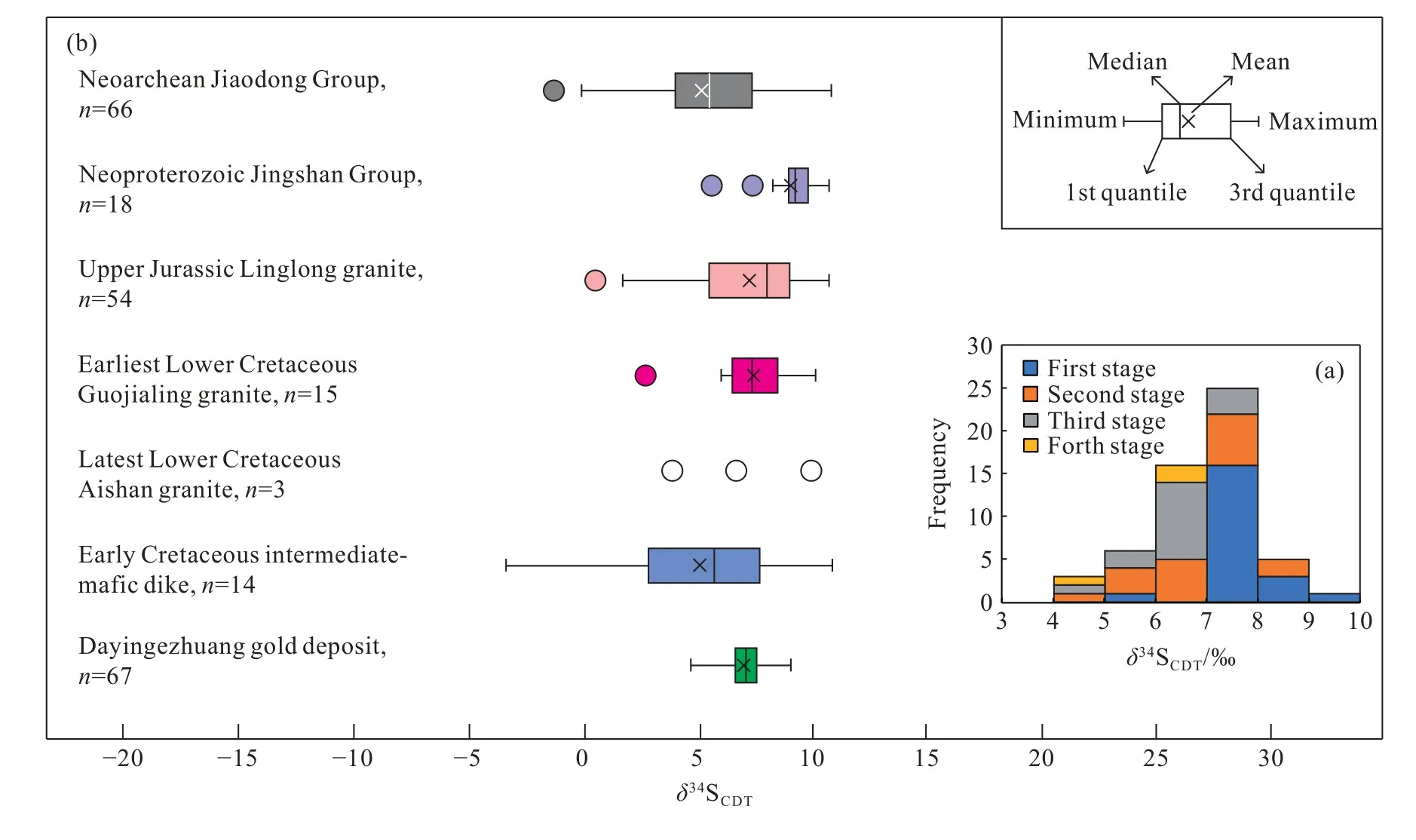
Fig. 16. a-Sulfur isotopic histogram in the Dayin’gezhuang gold deposit; b-comparison of sulfur isotopic compositions between Dayin’gezhuang gold deposit, Jiaodong Group, Jingshan Group, Mesozoic magmatic rocks, and intermediate-mafic dikes. Data source: Li ZL and Yang MZ, 1993; Mao JW et al., 2005; Hou ML et al., 2006; Dai XL, 2012; Zhang RZ et al., 2016; Yuan ZZ et al., 2019.

Fig. 17. Lead isotopic compositions of the Dayin’gezhuang gold deposit, shown on 207Pb/204Pb vs. 206Pb/204Pb (a) and 208Pb/204Pb vs.206Pb/204Pb (b). Data source: Cai YC et al., 2013; Chen ZS et al., 1994; Guan K et al., 1997; Li ZL and Yang MZ, 1993; Liu XF et al., 2018; Ma L et al., 2014; Ma ZD, 1998; Mao JW et al., 2005; Tan J et al., 2012; Yang SW et al., 1986; Yuan ZZ et al., 2019.
The S and Pb isotopic characteristics of the Dayin’gezhuang gold deposit are similar to those of the ore-hosting rocks, and theδ34SCDTvalues of the deposit are distributed more intensively than those of the ore-hosting rocks. This result indicates that the metallogenic materials mainly originate from ore-hosting rocks. Since the Jiaodong area underwent strong crust-mantle interactions during the Early Cretaceous, the ore-hosting rocks are dominated by crustderived materials and are significantly mixed with mantlederived materials. Therefore, the authors of this paper hold that the Dayin ’gezhuang gold deposit mainly has crustderived ore-forming materials, which also contain a small quantity of mantle-derived materials.
5.5. Genesis and metallogenic process of the Dayin’gezhuang gold deposit
The Dayin ’gezhuang gold deposit is hosted in the Zhaoping Fault zone. The hanging wall of this fault zone is mainly composed of Precambrian metamorphic rocks, and the footwall of the fault is composed of Upper Jurassic Linglong granites. Many mafic dikes are distributed in the deposit, and there are still Earliest Lower Cretaceous Guojialing and Weideshan granites (such as Aishan and Nansu plutons) near the deposit. These geological bodies and fault structures are closely related to gold mineralization. According to the diagenetic and metallogenic time, the geological bodies related to the Jiaodong gold deposits can be divided into orehosting geological bodies (including Precambrian metamorphic rocks and Linglong and Guojialing granites) and geological bodies during the ore-forming period (including Weideshan granites and mafic dikes). As indicated by relevant studies, the Linglong and Guojialing granites have the characteristics of adakites and resulted from the partial melting of the paleocrust (Wang B et al., 2021); the Weideshan granites have the characteristics of arc granites and arose from the partial melting of the juvenile lower crust,and the occurrence of dioritic inclusions in Weideshan granites and the widespread distribution of mafic dikes in the deposit indicate the existence of mantle-derived magmatism(Song MC et al., 2020b). These results indicate that gold mineralization occurred during the transition from adakitic granites to arc granites and the crust-mantle interactions. As shown by the thermochronological study results of granites,the Linglong granites slowly cooled from approximately 800°C at their formation age of 160 Ma to approximately 450±50°C at approximately 143 Ma (Charles N et al., 2013);the Guojialing granites cooled at a rate of 100°C/Ma from 130-126 Ma to 124 Ma; the Weideshan granites experienced a more rapid cooling process after forming and rapidly cooled to approximately 350±50°C at 122-118 Ma, and granites cooled at a rate of above 30°C/Ma at 117-110 Ma (Wu L et al., 2018). The thermochronological study of Jiaodong gold deposits after mineralization shows that they have experienced a very slow cooling and uplifting process since approximately 95 Ma, with a cooling rate of 0.4-2.4°C/Ma(Zhang QB et al., 2022). Therefore, the gold mineralization was accompanied by rapid crustal uplifting and cooling.
Based on the geological process characteristics related to gold mineralization mentioned above, the authors hold that the formation of the Dayin’gezhuang gold deposit is related to crust-mantle interactions, granite emplacement, the transformation of geochemical properties, and rapid crustal uplifting and that the Dayin’gezhuang gold deposit was formed by thermal-uplift and extensional tectonism (Song MC et al., 2014, 2022a). During the Upper Jurassic, the large-scale continental crust in the Jiaodong area remelted due to the post-collision and compression of the North China Plate and Yangtze Block, as well as the crustal thickening caused by the subduction of the Paleo-Pacific Plate or the Izanagi plate toward the Asian Continent, forming Linglong granites(Zhang YQ et al., 2007). During the Lower Cretaceous, the paleo North China Plate was destroyed due to the subduction and retreat of the Paleo-Pacific Plate. As a result, the lithosphere and the crust intensively thinned, and the asthenosphere upwelled, leading to intense crust-mantle material exchange (Zhu RX et al., 2011). The partial melting of the enriched lithospheric mantle produced mafic magmas,and the underplating of mantle-derived mafic magmas acted on the paleo or juvenile crust at the bottom, causing the partial melting of the rocks at the crust bottom (Qiu LG et al., 2008).Mantle-derived mafic magmas intruded upward and differentiated, forming lamprophyres and other dark dikes.Moreover, different degrees of mixing, crystallization, and differentiation of mantle- and crust-derived magmas formed Guojialing, Weideshan, and Laoshan granites (Wang B et al.,2021). The strong crust-mantle interactions, large-scale magmatism, and the material exchange arising from the transformation from adakitic granites to arc granites and from the ancient lower crust to the juvenile lower crust indicated by the granite transformation during the Lower Cretaceous provided abundant fluids and material sources for gold mineralization. The large-scale magmatism during the Lower Cretaceous was accompanied by the rapid uplifting of intrusions and the crust and strong extensional tectonism,forming a thermal-uplift extensional tectonic system (Song MC et al, 2015, 2018). Since the rapid uplift of magmas strongly jacked up the shallow surrounding rocks, many extensional fracture structures were formed in the early Linglong granites, and detachment faults were formed along the interface between the Linglong granites and the Precambrian metamorphic rocks, creating favorable space for accumulation and mineralization of ore-forming fluids.Moreover, as the magmas were uplifted rapidly, the temperature and pressure of fluids dropped sharply, resulting in immiscibility (phase separation) or boiling. Consequently,large numbers of components such as CO2, and H2S escaped,the pH of the system increased, and fluids containing metal elements such as Fe and Cu reacted with the fluids containing S, forming sulfides such as pyrites and chalcopyrite. The escape and consumption of components such as CO2and H2S reduced the stability of gold-bearing complex compounds in the fluids. Finally, golds in the form of native gold and electrum were precipitated and mineralized along with metal sulfides such as pyrites at the pressure fluctuation parts, i.e.,the high-to-low transition parts of the dip angle of detachment faults (Fig. 18).
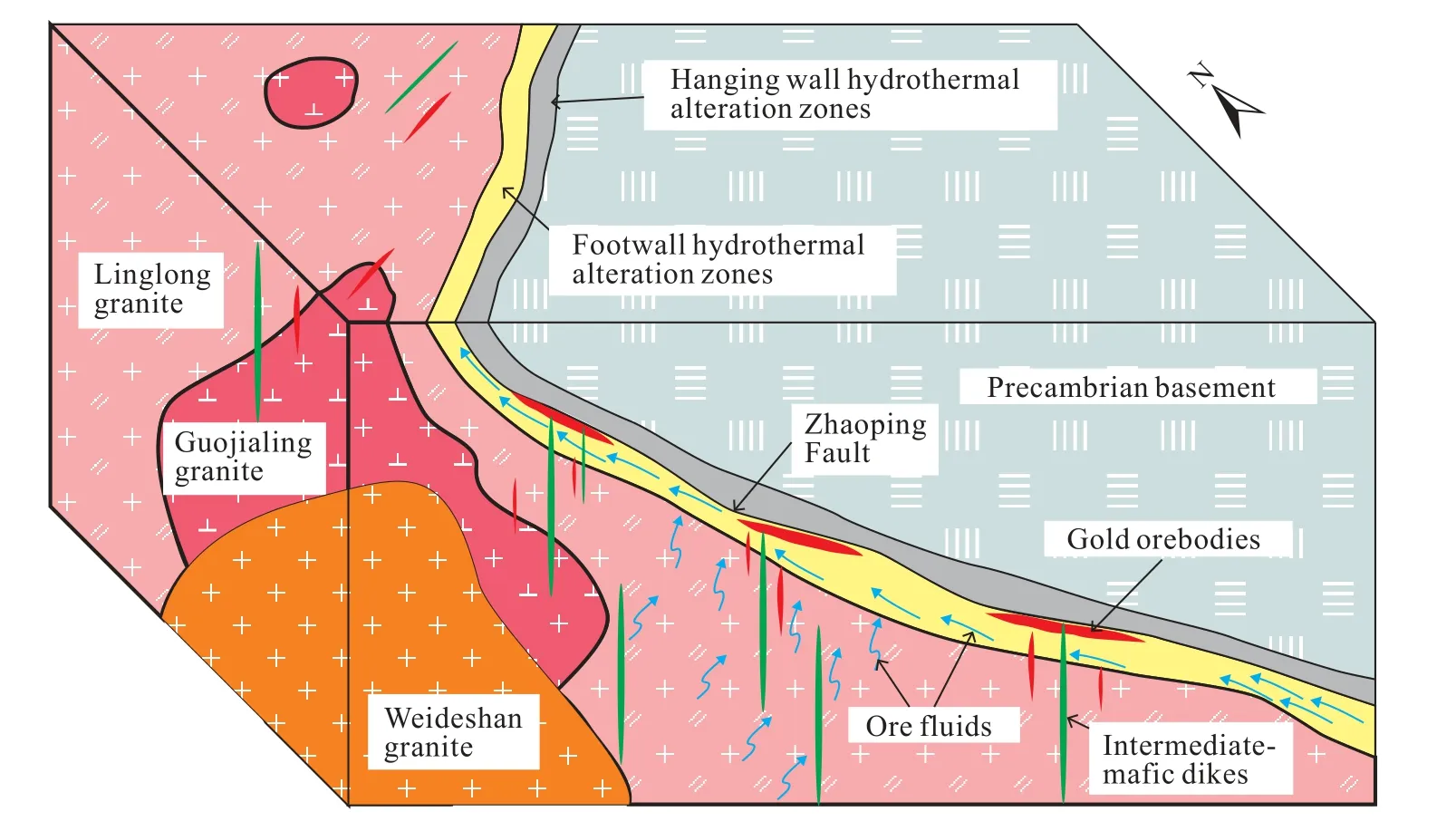
Fig. 18. A proposed cartoon illustrating the ore genesis of the Dayin’gezhuang gold deposit.
6. Conclusions
(i) The Dayin’gezhuang gold deposit is a supergiant gold deposit with total resources of more than 180 t and consists of No. 1 and No. 2 orebodies. The orebodies in the deposit are distributed with the regularity of pinch-out and recurrence,and ore-free intervals exist between the deep and shallow orebodies. The orebodies have a pitch direction of NNE, a pitch angle of approximately 55°, a plunge direction of NEE 75°, and a plunge angle of approximately 22°. The orecontrolling Zhaoping Fault is a shovel-shaped stepped fault,and the fault dip angle presents three sections of stepped highto-low transitions at an elevation of -2000-0 m. The gold mineralization enrichment areas are mainly distributed in the high-to-low transition parts of the dip angle and the relatively gentle steps, forming a stepped pattern from shallow to deep.
(ii) The Dayin’gezhuang gold deposit was formed at approximately 120 Ma. The ore-forming fluids were H2OCO2-NaCl-type hydrothermal solutions with medium-low temperature and medium-low salinity. The fluids evolved from high to medium and then low temperature, and the fluid immiscibility occurred at the main ore-forming stages (II and III). The H-O isotopic characteristics indicate that the early fluids may originate from the magmatic fluid system with crust-mantle interactions, and the late fluids may have been mixed with much meteoric water. The S and Pb isotopic characteristics indicate that the Dayin’gezhuang gold deposit mainly has crust-derived ore-forming materials, which also contain a small quantity of mantle-derived materials.
(iii) The Dayin’gezhuang gold deposit was formed by thermal uplift and extensional tectonism. The strong crustmantle interactions, large-scale magmatism, and the material exchange arising from the transformation from adakitic granites to arc granites and from the ancient lower crust to the juvenile lower crust during the Lower Cretaceous provided abundant fluids and material sources for mineralization.Moreover, the detachment faults formed by the rapid magmatic uplift and the extensional tectonism created favorable temperature and pressure conditions and space for fluid accumulation and gold precipitation and mineralization.
CRediT authorship contribution statement
Ming-chun Song, Zheng-jiang Ding and Ming-ling Zhou conceived and designed the ideas. Xiang-dong Liu prepared the manuscript, and drew all the figures. Shao-hui Xu, Zhenliang Yang, Tian-ci Xie, Xue-kan Gao, Rui-xiang Li participated in field investigation. Liang-liang Zhang, Qi-bin Zhang, Shan-shan Wang, and Bin Wang performed the data processing. Tao Cui and Ying-xin Song reviewed and edited the draft. All authors discussed the results and contributed to the final manuscript.
Declaration of competing interest
The authors declare no conflicts of interest.
Acknowledgment
Professor Kun-feng Qiu and Researcher Jun-jian Li reviewed the entire manuscript and proposed valuable comments. The authors hereby would like to extend their sincere gratitude to them. This paper was financially supported by the NSFC-Shandong Joint Fund Program entitled “Control Mechanisms of Faults on Deep Gold Deposits in Jiaodong Peninsula” (Grant No. U2006201),Science and Technology Project of Shandong Bureau of Geology and Mineral Exploration and Development entitled“Fault system and its relationship with gold mineralization,northwestern Jiaodong Peninsula” (Grant No. KY202208) and Open Fund of Big Data Application and Development Engineering Laboratory for Deep Gold Exploration in Shandong Province entitled “Ore-forming fluid and oreforming material source of Jiudian gold deposit, Jiaodong”(Grant No. SDK202211).
杂志排行
China Geology的其它文章
- Discovery of Miocene pegmatite type Be-Nb-Ta(-Rb) mineralization in the Yangbajain of Central Lhasa subterrane, Tibet
- Origin, discovery, exploration and development status and prospect of global natural hydrogen under the background of “carbon neutrality”
- Geological characteristics, metallogenic regularity, and research progress of lithium deposits in China
- 2022 Annual Report of China Mineral Resources (lithium, nickel, cobalt, REE etc.)
- Comment on “Geological mapping and mining prospecting in the Aouli inlier (Eastern Meseta, Morocco) based on remote sensing and geographic information systems (GIS)”by Benaissi et al. (China Geology, 5 (2022))
- Innovative understanding in the geological research of China seas and adjacent regions -based on the 1∶1000000 marine regional geological survey
